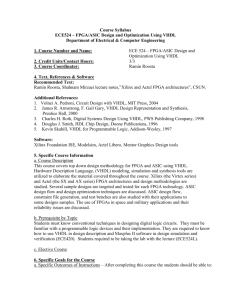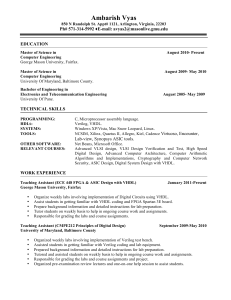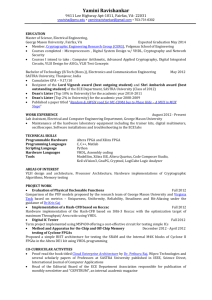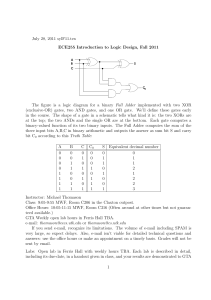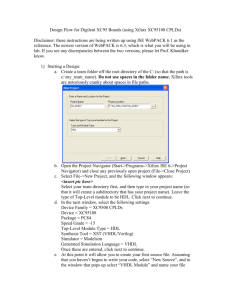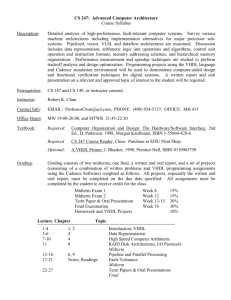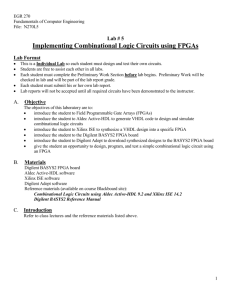EE596 (Experimental Course)
advertisement
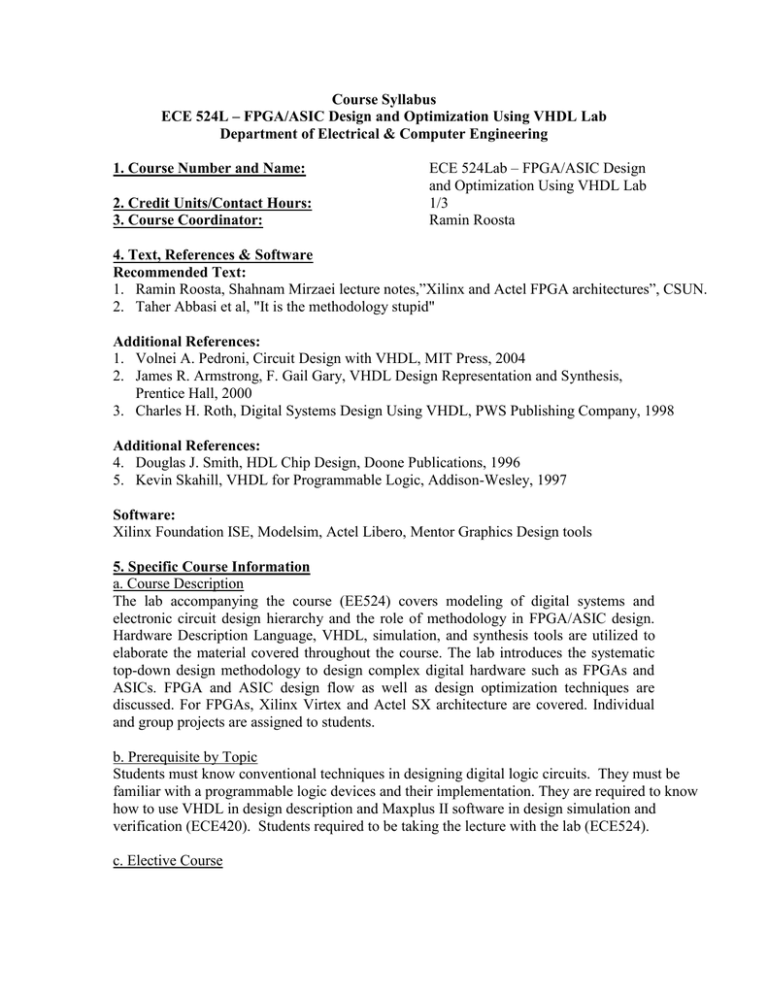
Course Syllabus ECE 524L – FPGA/ASIC Design and Optimization Using VHDL Lab Department of Electrical & Computer Engineering 1. Course Number and Name: 2. Credit Units/Contact Hours: 3. Course Coordinator: ECE 524Lab – FPGA/ASIC Design and Optimization Using VHDL Lab 1/3 Ramin Roosta 4. Text, References & Software Recommended Text: 1. Ramin Roosta, Shahnam Mirzaei lecture notes,”Xilinx and Actel FPGA architectures”, CSUN. 2. Taher Abbasi et al, "It is the methodology stupid" Additional References: 1. Volnei A. Pedroni, Circuit Design with VHDL, MIT Press, 2004 2. James R. Armstrong, F. Gail Gary, VHDL Design Representation and Synthesis, Prentice Hall, 2000 3. Charles H. Roth, Digital Systems Design Using VHDL, PWS Publishing Company, 1998 Additional References: 4. Douglas J. Smith, HDL Chip Design, Doone Publications, 1996 5. Kevin Skahill, VHDL for Programmable Logic, Addison-Wesley, 1997 Software: Xilinx Foundation ISE, Modelsim, Actel Libero, Mentor Graphics Design tools 5. Specific Course Information a. Course Description The lab accompanying the course (EE524) covers modeling of digital systems and electronic circuit design hierarchy and the role of methodology in FPGA/ASIC design. Hardware Description Language, VHDL, simulation, and synthesis tools are utilized to elaborate the material covered throughout the course. The lab introduces the systematic top-down design methodology to design complex digital hardware such as FPGAs and ASICs. FPGA and ASIC design flow as well as design optimization techniques are discussed. For FPGAs, Xilinx Virtex and Actel SX architecture are covered. Individual and group projects are assigned to students. b. Prerequisite by Topic Students must know conventional techniques in designing digital logic circuits. They must be familiar with a programmable logic devices and their implementation. They are required to know how to use VHDL in design description and Maxplus II software in design simulation and verification (ECE420). Students required to be taking the lecture with the lab (ECE524). c. Elective Course 6. Specific Goals for the Course a. Specific Outcomes of Instructions – After completing this course the students should be able to: 1. Ability to utilize the top-down design methodology in the design of highly complex digital devices such as FPGAs/ASICs. 2. Ability to use learn/use modern hardware/software design tools to develop modern digital systems 3. Ability to design verification and test of integrated circuits chips 4. Ability to design, implement and test different Field Programmable Gate Array (FPGA) architectures and their Applications to real life such as cell phones, PDAs, etc. 5. Ability to participate in team projects including design inspection and optimization 6. Ability to understand the reliability issues of the highly complex devices in harsh military and space applications b. Relationship to Student Outcomes This supports the achievement of the following student outcomes: a. An ability to apply knowledge of math, science, and engineering to the analysis of electrical and computer engineering problems. b. An ability to design and conduct scientific and engineering experiments, as well as to analyze and interpret data. c. An ability to design systems which include hardware and/or software components within realistic constraints such as cost, manufacturability, safety and environmental concerns. e. An ability to identify, formulate, and solve electrical and computer engineering problems. g. An ability to communicate effectively through written reports and oral presentations. k. An ability to use modern engineering techniques for analysis and design. m. An ability to analyze and design complex devices and/or systems containing hardware and/or software components. 7. Topics Covered/Course Outline 1. Introduction to VHDL Design Flow 2. Introduction to CAD tools 3. Exploring Xilinx Foundation ISE ,Actel Libero, and ModelSim 4. Implementing Counters / Shift Registers 5. Traffic Light Controller Design 6. Finite State Machine Design 7. Drink Dispenser Controller Design 8. Memory Controller Design (RAM and ROM) 9. Error Detection and Correction 10. Three way round robin controller 11. Pipelined Adder Prepared by: Ramin Roosta, Professor of Electrical and Computer Engineering, November 2011 Ali Amini, Professor of Electrical and Computer Engineering, March 2013
